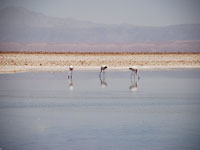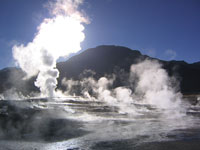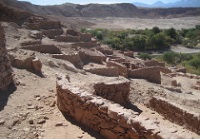San Pedro de Atacama Travel Guide
The desert oasis village of San Pedro de Atacama, which has been continuously inhabited for about 10,000 years, was prized by the Inca and Tiahuanaco empires for its mineral wealth and importance as a stopover on the caravan trade routes. It sits at the northern end of the Salar de Atacama, a vast salt lake desert that is home to a variety of bird life and some bizarre but truly beautiful landscapes.
Today San Pedro de Atacama is one of the major travel destinations of northern Chile and an attractive, albeit touristy village with a laid-back atmosphere and the simple, low-slung adobe buildings typical of the region. A great base from which to explore the astounding natural beauty of the region, the village has few real attractions of its own. There is a small 17th-century church built with local materials and a small well-organised museum with a good gift shop that sells the only truly locally-produced crafts in the town.
There are a number of restaurants and bars to enjoy, a particularly welcome relief after days spent exploring the surrounding desert, but local restrictions on liquor sales see the nightlife come to a halt at about 11.30pm on weekdays and Sundays and 2am on weekends. Authorities seem to have made a conscious decision to discourage a party culture in San Pedro, but many visitors will salute this move as the region boasts some of the best stargazing on earth and the desert silence is a joy when it can be experienced.
There is plenty to see and do around San Pedro, which is ideally situated as a springboard to some of Chile's most wondrous attractions. The town is close to interesting archaeological sites, the salt flats and Valle de la Luna, and lies within easy reach of the nearby Lagunas Altiplanicas and the El Tatio Geysers. Outdoor activities such as mountain climbing and sandboarding are popular, or for those keen on a bit relaxation the hot springs of Puritama are not far away.
Almost every shop along the main road sells tours to the various attractions in the area, or hires out bicycles. Bikes can be rented daily and many of the top attractions are within cycling distance, including the famous Valle de la Luna and the Pukara de Quitor Ruins. Those exploring independently should make sure they are prepared for the heat of the desert and take plenty of water on excursions.
Things to do in San Pedro de Atacama
San Pedro de Atacama is not famous for its sightseeing opportunities but rather because it is situated in the midst of an adventurer's paradise of deserts, mountains, lagoons and salt pans.
Travellers typically use the village as a home base while exploring the astounding surrounding landscapes. Which is not to say the town is not worthy of mention; it just pales in comparison to its surroundings. Sandboarding, hiking, horse riding and mountain biking are all commonly enjoyed activities in the area. And once travellers are stiff and exhausted from all their thrilling outdoor escapades, there is nothing better than visiting the Puritama Hot Springs to soak it all away in the naturally hot water, or sitting in one of the shady alcoves of a bar on the main plaza with an ice-cold cocktail in hand.
One unmissable attraction in San Pedro de Atacama is Pukara de Quitor. These ancient, pre-Incan ruins are less than an hour's walk from the centre of town and, although the fortifications are not as impressive in scale as some of the mammoth ruins of South America, the views from the site are spectacular. Also close to the town are the El Tatio Geysers and the opportunity to experience this unique, steamy environment should not be passed up. In addition, there are a number of lagoons high up on the plateau which never fail to delight visitors.
The Reserva Nacional Los Flamencos is said to be the most popular nature reserve in Chile, which is really saying something in a country that boasts so many truly breathtaking wilderness areas. The Valley of the Moon, a surreal salt lake landscape, is one of the most popular destinations within the park and can actually be reached comfortably by bike from San Pedro for those who would prefer to avoid the crowded tours. It is a huge reserve with many areas worth exploring for the beautiful desert scenery and interesting flora and fauna.

Reserva Nacional Los Flamencos
This popular nature reserve in northern Chile (many claim it is the most popular) is 459 square miles (740km sq) and is divided into seven sections, all offering highlights of their own. One of the most interesting areas within the Reserva Nacional Los Flamencos is the Valle de la Luna (Valley of the Moon), a surreal landscape of salt peaks formed by uplifted lake sediments that have been shaped into dramatic formations by wind erosion. The valley's unearthly blend of pastel colours makes it even more enchanting at sunset. Close to San Pedro de Atacama, the valley can be reached by mountain bike or on a guided tour.
A striking feature of northern Chile's geography is the shimmering and apparently endless salt lakes, home to many bird species. The Salar de Atacama (Salt Flat of Atacama) in the reserve has a lagoon, Laguna Chaxa, which supports three species of flamingos as well as other bird life.
The salt lake also affords good views of the volcanoes in the Andean chain of mountains on the nearby altiplano (high plain). The stunning desert landscape offers many attractions: hiking, horse riding, bird watching and photography among them. Visitors should be aware that, in this desert region, temperatures vary dramatically and can drop suddenly.

El Tatio Geysers
At an altitude of 13,760 feet (4,300m) El Tatio is one of the world's highest and hottest geyser fields, and is surrounded by volcanoes and fed by 80 geysers and hundreds of gassy fumaroles. The geyser fields are best viewed at sunrise when there are changes in atmospheric pressure; the steaming fumaroles are particularly spectacular at this time, shooting clouds of steam about 35 feet (112m) into the air.
While it is possible to bathe in the hot geyser water in a small pool, parts of the field are highly dangerous, with only a thin crust over nearly boiling mud, so it is always a good idea to visit the geysers with a knowledgeable guide.
It's a glorious attraction for photographers as the steam and the odd landscape make for dramatic scenes. The geysers are not advisable for anybody who has respiratory issues, though, so visitors with breathing problems should proceed with caution. Visitors should also be sure to wear layers as it is much warmer at the geysers, even though the pre-dawn temperatures are freezing.
Most travellers visit the geysers as part of a guided tour. These usually leave San Pedro de Atacama early in the morning. Many operators offer this trip and it is worth shopping around to find the best option. A number of geyser tours include a stop at nearby hot springs in the desert, which is a great addition.

Pukara de Quitor Ruins
The Pukara de Quitor Ruins are a short distance from the town and one of the most popular attractions in San Pedro de Atacama. The fortifications were built by the pre-Incan Atacameno civilisation in the 12th century. The ruins have not been excavated fully, despite being incredibly well preserved, as they will be quickly destroyed by the elements if they are exposed further.
The way they stand, half-uncovered, actually adds to the mystique of the place, and visitors can still have a fair idea of what the structures would have looked like originally. To help travellers envisage the buildings as they once were, a replica of one of the 800-year-old houses has been built.
A bike ride or a quick hike to the ruins is one of the most popular things to do in San Pedro de Atacama. The distance is under three miles (4km) and can be walked in about an hour. The path is well sign-posted and not demanding. Possibly the most astounding part about the fort are the views from the site, and even those visitors who have seen more extensive and impressive ruins, such as those just north in Peru, will still be blown away by the vistas. The ruins can be explored with remarkable freedom, which is also a bonus.
San Pedro de Atacama Climate and Weather
San Pedro de Atacama has a cold desert climate and experiences extremely dry weather, with little or no rainfall and temperatures averaging between 77F and 86F (25C and 30C) in the summer months from December to January. During the winter months, from June to August, the temperature averages drop to between 64F and 77F (18C and 25C) during the day, while average nighttime temperatures in winter drop to below zero and can even reach as low as 14F (-10C). Some visitors experience altitude sickness and travellers should take this into account. Altitude sickness can manifest as dizziness, lethargy or headaches. If travellers have any respiratory problems, travel in this area may be difficult for them due to the altitude. The weather in San Pedro de Atacama is ultimately quite pleasant all year, considering that it is located in a desert, and there isn't really a peak tourist season or an ideal time to visit. The season of stay should be determined by the activities visitors want to try.
Chile travel info
Electricity
Electrical current is 220 volts, 50Hz. Round two-pin plugs and round three-pin plugs are used.
Language
The official language is Spanish.
Money
The local currency is the Chilean peso (CLP), which is divided into 100 centavos. Visa, MasterCard, Diners Club and to a lesser extent, American Express, are accepted in most large shops and hotels. ATMs are widely available.
Tipping
Tips of about 10 percent are expected in restaurants; it's usual to round up the fare for taxi drivers if they help with the luggage. Tipping small amounts is customary for most services.
Health
All eligible travellers should be up to date with their COVID-19 vaccines; vaccinations for hepatitis A, hepatitis B are recommended, and a typhoid vaccine may be recommended for long-term travellers who plan to visit rural areas and eat outside of hotels and restaurants. Water is generally safe in the cities, but should be treated in the rural areas; bottled water is widely available for drinking. Santiago is severely polluted and this could cause respiratory problems or eye irritations, particularly between May and August. Travellers visiting the Andes Mountains should be aware of altitude sickness, and ascend slowly to allow the body to adjust. Healthcare in urban areas is generally good, but hospitals and clinics are expensive. Comprehensive travel health insurance is recommended.
Safety
Chile is a politically stable country with few safety threats to travellers. Incidences of pick-pocketing and mugging are on the increase in big cities and travellers should take care of their belongings, especially around tourist areas and bus stations. Travellers should also avoid walking alone late at night, and should be particularly cautious in Valparaiso and the capital, Santiago, where theft is on the increase, and muggings are becoming more common in popular walking areas such as Cerro San Cristobal, Cerro Santa Lucia and Cerro Manquehue. There has been an increase in reports regarding people receiving spiked drinks at nightclubs and bars, particularly in Santiago. Travellers should avoid any involvement in political protests and demonstrations, which take place from time to time. Chile has a landmine problem, which is mainly restricted to border areas adjacent to Peru and Bolivia. These areas are seldom visited by most travellers, so landmines shouldn't be a problem. However, visitors are advised to stick to marked roads, obey all signs and seek the advice of local authorities if travelling to these areas.
Local customs
Although Chile is largely conservative in outlook, homosexuality is legal and is increasingly widely accepted socially. Punishment for the possession and consumption of drugs is illegal and can lead to prison sentences.
Doing business
Chilean business culture tends to be formal, and this includes dress, which should also be conservative. In business, Chileans should be addressed by their titles and surnames, unless otherwise stated. Businesses are often family run. Third party introductions are indispensable when arranging a meeting, and developing a personal relationship is key. Chileans often stand very close when conversing and it is impolite to pull away. Visitors are also expected to re-confirm appointments before arriving at a meeting. Foreigners should be on time for meetings, but it is not unusual for the host to be 15 to 30 minutes late. On introduction, a firm handshake and exchange of business cards is usual; cards should be printed in both English and Spanish, and it's important to pay attention to the card before putting it away carefully. Business hours are generally 9am to 5pm Monday to Friday, often with a siesta over lunch.
Duty free
Travellers entering Chile do not need to pay customs duty on 400 cigarettes, 50 cigars (large or small) and 500g tobacco; 2.5 litres of alcohol; and perfume for personal use. Meat products, flowers, fruit and vegetables may only be imported if permission is given by the Department of Agriculture.
Communications
The international access code for Chile is +56. The outgoing code is 00 followed by the relevant country code (e.g. 0044 for the United Kingdom). Hotels, cafes and restaurants offering free WiFi are widely available. As international roaming costs can be high, purchasing a local prepaid SIM card can be a cheaper option.
Passport & Visa
A return or onward ticket is required, and it's recommend that passports be valid for six months after the intended period of travel. Extension of stay is possible for an additional 90 days for visa exempt visitors.
Entry requirements
No visa is required by US nationals for visits of up to 90 days, though a passport valid on arrival is required for travel to Chile. Travellers who visit Easter Island are allowed to stay for a maximum of 30 days.
UK nationals do not require a visa for visits of up to 90 days, though a passport valid on arrival is required. Travellers who visit Easter Island are allowed to stay for a maximum of 30 days.
No visa is required by Canadians for visits of up to 90 days; a passport valid on arrival is required for travel to Chile. Travellers who visit Easter Island are allowed to stay for a maximum of 30 days.
Australian nationals require a visa and passport valid on arrival. Travellers who visit Easter Island are allowed to stay for a maximum of 30 days.
South African nationals must hold a passport valid on arrival, though a visa is not required for stays of up to 90 days. Travellers who visit Easter Island are allowed to stay for a maximum of 30 days.
Irish nationals must hold a passport valid on arrival, but a visa is not required for a stay of up to 90 days. Travellers who visit Easter Island are allowed to stay for a maximum of 30 days.
New Zealand nationals must hold a passport valid on arrival, though a visa is not required for a stay of up to 90 days. Travellers who visit Easter Island are allowed to stay for a maximum of 30 days.
Useful contacts
Chile National Tourism Website: www.chile.travel
133 (Police); 131 (Medical)Embassies / consulates in other countries
Embassy of Chile, Washington DC, United States: +1 202 530 4104.
Embassy of Chile, London, United Kingdom: +44 (0)20 7222 2361.
Embassy of Chile, Ottawa, Canada: +1 613 235 4402.
Embassy of Chile, Canberra, Australia: +61 (0)2 6286 2430.
Embassy of Chile, Pretoria, South Africa: +27 (0)12 460 8090.
Embassy of Chile, Dublin, Ireland: +353 (0)1 667 5094.
Embassy of Chile, Wellington, New Zealand: +64 (0)4 471 6270.
Embassies / consulates in Chile
United States Embassy, Santiago: +56 (0)2 330 3000
British Embassy, Santiago: +56 (0)2 370 4100.
Canadian Embassy, Santiago: +56 (0)2 652 3800.
Australian Embassy, Santiago: +56 (0)2 550 3500.
South African Embassy, Santiago: +56 (0)2 8200 300.
Embassy of Ireland, Buenos Aires (also responsible for Chile): +54 11 5787 0801.
New Zealand Embassy, Santiago: +56 (0)2 616 3000.



